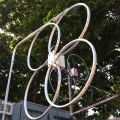G8JNJ
About
- Username
- G8JNJ
- Joined
- Visits
- 4,628
- Last Active
- Roles
- Member
- Points
- 127
Reactions
-
More GPS Problems - Damaged hardware?
Some further notes for anyone who may pick up this thread at a later date and wish to copy this information.
If you wish to split the GPS signal from the antenna to feed multiple KiWI's.
Do not attempt to simply use a tee adaptor or similar to split the feed, as this will introduce unpredictable impedance excursions on the coax cables, which is turn will result in very deep 'notches' in the signal amplitude at various frequencies.
You can only use passive splitters if the antenna has sufficient gain to overcome the splitting losses and cable losses ahead of the KiWi.
2 way split = approx 3.5dB additional loss
3 way split = approx 5dB additional loss
4 way split = approx 7dB additional loss
Try to find passive splitters that only have a DC pass on one port. This will save having to fit additional external DC blocks in order to prevent one KiWi feeding DC back into another via the GPS connectors.
Make sure they are rated up to 2GHz, like this model / style
https://www.amazon.com/Ideal-85-332-2-Way-Digital-Splitter/dp/B003QM9UHS/ref=sr_1_2?keywords=ideal+2+way+splitter&qid=1563704237&s=gateway&sr=8-2
https://www.amazon.com/Ideal-85-334-4-Way-Digital-Splitter/dp/B003V18KQ6/ref=sr_1_3?keywords=ideal+4+way+splitter&qid=1563704346&s=gateway&sr=8-3
You can obtain 'F' type male to SMA male patch cables on Ebay at under $4 each. It's better to buy ones that are longer than you need, so that there is room to wrap them around ferrite rings if required. Make sure you choose the correct sex of connectors, as reverse SMA is quite common.
https://www.ebay.com/itm/RG316-Cable-F-Type-male-plug-to-SMA-male-plug-RF-Pigtail-Coax-Jumper/273406498020?hash=item3fa84c14e4:m:mFvLi09dwBokRt1mcM3MNiQ
Hope this helps anyone else following in these footsteps.
Regards,
Martin - G8JNJ -
More GPS Problems - Damaged hardware?
Hi Chris,
I use passive satellite TV splitters with an inbuilt DC block (or steering diodes) on all but one port.
This sort of thing with suitable adaptors.
I use a two way to feed two more two ways, so that I can feed the office and workshop (Trimble) with a mid point split, This gives about about 7-8dB loss in total on each leg, which is fine with an antenna with 40dB of amplification.
Regards,
Martin - G8JNJ -
TDoA background maps not loading
>
>John, is it possible to have the basic (landmass boundaries) maps that TDoA used when I first got my Kiwi last summer?
>Presumably the multiple TDoAs I do when I TDoA in order to see the results "group" requires the same map tiles be loaded that many >times. I'm only interested in the coordinates. Landmass boundary maps I'm guessing might not have that problem... but then what do I >know?
>
Brett's suggestion is a good one.
I use the TDoA function a lot, and I'm concerned about the costs to John associated with the provision of maps.
Maybe have the option for no map, just the co-ordinates overlay, then once you have got a good plot you can re-run it with the required map turned on. This would save downloading tiles and additional cost.
Regards,
Martin - G8JNJ -
Advice on sharing RX antennas with 3 SDRs in the most effective way
Be careful regarding some of the commercial active splitters. Their IMD performance is not that good as they often use MMIC chips that can only achieve modest performance.
For example the Elad unit specifies an output IP3 of >24dBm, which is not particularly good, and would be typical of something using a PGA-103+ or similar as the active device which will provide an IMD performance of around an IOP2 of +50dBm and IOP3 of +30dBm.
My suggestion would be to use something like the DX Engineering RPA-1 followed by a Mini-Circuits splitter.
I've built a copy of the RPA-1 and it works well from about 10KHz to 40MHz and I have measured the IMD performance as an IOP2 of +92dBm and IOP3 of +45dBm.
Details are on my Active antennas web page.
https://www.g8jnj.net/activeantennas.htm
For GPS splitting you can use active L-Band splitters that were originally designed for distributing satellite TV services.
https://cpc.farnell.com/global-communications/split4af/4-way-active-splitter/dp/SE00009
I used this one but modified by cutting some tracks and adding an internal regulator so that it provided +5v out to feed the GPS antenna
Regards,
Martin - G8JNJ -
SAQ 17.2KHz - 30th June 2019
Good signals into the UK this morning from SAQ on 17.2KHz using an historic alternator transmitter
https://alexander.n.se/?lang=en
15dB above the noise floor into Farnham WEB SDR http://farnham-sdr.com/ in SE UK
12dB above the noise floor into Kernow KiWI WEB SDR http://kernow.hopto.org:8073/ at Goonhilly Earth Station in Cornwall SW tip of UK (despite a very high noise floor)
Unfortunately too much switched mode power supply noise on my SWUK KiWi SDR http://southwest.ddns.net:8073/ which masked the SAQ signal.
Another transmission due later today at 13.30 (11.30 UTC) the alternator starts and at 14.00 (12.00 UTC) will be broadcasting a message
Martin G8JNJ (Admin for Farnham / Kernow and SWUKSDR) -
SAQ 17.2KHz - 30th June 2019
Good signals into the UK this morning from SAQ on 17.2KHz using an historic alternator transmitter
https://alexander.n.se/?lang=en
15dB above the noise floor into Farnham WEB SDR http://farnham-sdr.com/ in SE UK
12dB above the noise floor into Kernow KiWI WEB SDR http://kernow.hopto.org:8073/ at Goonhilly Earth Station in Cornwall SW tip of UK (despite a very high noise floor)
Unfortunately too much switched mode power supply noise on my SWUK KiWi SDR http://southwest.ddns.net:8073/ which masked the SAQ signal.
Another transmission due later today at 13.30 (11.30 UTC) the alternator starts and at 14.00 (12.00 UTC) will be broadcasting a message
Martin G8JNJ (Admin for Farnham / Kernow and SWUKSDR) -
SAQ 17.2KHz - 30th June 2019
Good signals into the UK this morning from SAQ on 17.2KHz using an historic alternator transmitter
https://alexander.n.se/?lang=en
15dB above the noise floor into Farnham WEB SDR http://farnham-sdr.com/ in SE UK
12dB above the noise floor into Kernow KiWI WEB SDR http://kernow.hopto.org:8073/ at Goonhilly Earth Station in Cornwall SW tip of UK (despite a very high noise floor)
Unfortunately too much switched mode power supply noise on my SWUK KiWi SDR http://southwest.ddns.net:8073/ which masked the SAQ signal.
Another transmission due later today at 13.30 (11.30 UTC) the alternator starts and at 14.00 (12.00 UTC) will be broadcasting a message
Martin G8JNJ (Admin for Farnham / Kernow and SWUKSDR) -
Wellgood balanced loop amplifier, (Wellbrook clone).
Hi John,
Build the LZ1AQ instead.
It's a better performer and easier to construct, plus I'm not 100% convinced about George's reverse engineered circuit, especially the transformer windings and specifically the configuration on the binocular core. Norton amplifiers bring about lots of other problems and after playing with a lot of different designs, I'm not sure they are worth the effort.
My initial IMD measurements were constrained by my test setup, with my better test rig I measure
LZ1AQ OIP2 +79dBm OIP3+36dBm
Wellgood OIP2 +57dBm OIP3+37dBm (note that the Wellgood is based on an early Wellbrook design and the new ones are better)
The overall performance of all loops, especially on the HF bands is determined by loop size and inductance and amplifier input impedance. This is why most loops 'run out of steam' above about 10MHz.
I've found that contrary to most wisdom, if you can't build a nice 'fat' low inductance loop, it would seem to be better to use an amplifier with a higher value of input impedance (tens of Ohms), in order to improve performance on the HF bands (where the loop inductive reactance dominates the feed point impedance), and compromise a bit on the LF bands, where the natural noise floor tends to be a lot higher (particularly in urban areas) and the very strong Broadcast Stations tend to be problematic anyway.
Some more info on my Active antennas web page
https://www.g8jnj.net/activeantennas.htm
Here's a link I found to a lot of Clifton Labs Norton amplifier circuits (grab them while you can) that may be of interest to you and others on here (use Google translate)
https://www.okdxf.eu/index.php/technika/262-manualy-konstrukci-clifton-laboratories-k8zoa
Interestingly for some reason they also produced a higher gain amplifier using four Gali-74's the Z10046A, but I still haven't been able to track down a circuit of the amplifier they produced for the Pixel Loop now sold by DX Engineering (they have withdrawn all Clifton Labs on-line circuit diagrams since they bought them) as the RF-PRO-1B
https://www.dxengineering.com/parts/dxe-rf-pro-1b
Send me a private message if you wish.
Regards,
Martin - G8JNJ -
Aricebo - 5125KHz
I just realised that I got the project reference incorrect, as I'd worked out the wrong time from the schedule.
So the final session is now up and running until I estimate 18:00 UTC 14th June 2019
I can now hear the carrier being swept on the Anasco, Puerto Rico WEB SDR http://kp4ca.ddns.net:8073/ but not on mine yet.
They are using the dish.
Simulation and modeling results show that both arrays have
VSWRs less than 2:1 over a 100 kHz bandwidth no matter what the
state of the other passive arrays feed is (shorted, open, or terminated).
The gain at 5.1 MHz was 22.2 dBi. When fed with 600 kW of power,
this corresponds to an ERP of 99.6 MW. At 8.175 MHz, the gain was
25.5 dBi corresponding to an ERP of 212.9 MW. If the array is phased
to achieve circular polarization of either RHC or LHC, the crosspolarization from the opposite mode was above 27 dB for both
frequencies.
http://www.naic.edu/~astro/ao50/Arecibo_50th_Paper_Breakall_revised_Oct_23_2013.pdf
Here's the correct reference and summary of work.
General Category: Astronomy
Observation Category: Ionosphere
Total Time Requested: 24 Hours
Minimum Useful Time:
Proposal Title: Natural Analogs Via Ionospheric Experimental Research (NAVIER)
ABSTRACT:
This proposal is in collaboration with the planned NRL Probing Regions via Ionospheric Modi?cation (PRIM)
experiment, the goal is to study the physics of plasma irregularities created by the Arecibo HF Heater and their
impact on HF communications waveforms. MITRE will be providing an advanced HF transmitter and receiver pair
as well as standard HF radios to study the impact of arti?cial ?eld-aligned irregularities (AFRIs) on the HF signal
propagation. The locations of transmit and receive sites will be the Dominican Republic and St. Thomas
respectively. This a?ords a near-to-perpendicular signal propagation path with respect to the geomagnetic ?eld
lines over Arecibo, as shown in Figure 1. The outcomes of this experiment will include investigation of the physics
of the disturbed ionosphere, as well as a large-scale data collection and analysis on the impacts of heater AFRIs on
HFnear vertical incidence skywave (NVIS) propagation.
Name Institution E-mail Phone Student
Edlyn V. Levine MITRECorporation evlevine@... 412-7265480 no
Remote Observing Request
X Observer will travel to AO
Remote Observing
In Absentia (instructions to oper-
ator)
Instrument Setup
430 Xmit
Atmospheric Observation Instruments:
Tilt-Photometer Spectrophotometer Fabry-Perot Ionosonde Lidar
Description of Observer Equipment: MITRE will provide a Digisonde ionospheric sounder for 1
deployment near to the Arecibo facility. MITRE will appreciate the AO support to deploy the instrument
Special Equipment or setup: The ISR will be the primary instrument as well as our own
diagnostics. The other instruments are a backup.
RFI Considerations
Frequency Ranges Planned
2
Sweep rate is 100mS occupying 26KHz.
Scope and Spectrum plots attached but I was only able to sample in a 10KHz BW.

Regards,
Martin - G8JNJ -
RF Pro-1B Issue Developing







